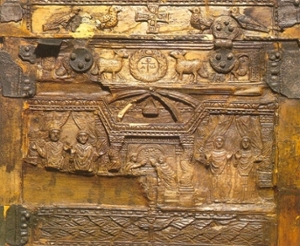The Patristic Christian Veneration of the Martyrs and Saints
"Not only today, therefore, but every day let us go forth to him, plucking spiritual fruits from him. For it is, it is possible for him who comes hither with faith to gather the fruit of many good things. For not the bodies only, but the very sepulchers of the saints have been filled with spiritual grace. For if in the case of Elisha this happened, and a corpse when it touched the sepulcher, burst the bands of death and returned to life again, much rather now, when grace is more abundant, when the energy of the spirit is greater, is it possible that one touching a sepulcher, with faith, should win great power; thence on this account God allowed us the remains of the saints, wishing to lead by them us to the same emulation, and to afford us a kind of haven, and a secure consolation for the evils which are ever overtaking us. Wherefore I beseech you all, if any is in despondency, if in disease, if under insult, if in any other circumstance of this life, if in the depth of sins, let him come hither with faith, and he will lay aside all those things, and will return with much joy, having procured a lighter conscience from the sight alone. But more, it is not only necessary that those who are in affliction should come hither, but if any one be in cheerfulness, in glory, in power, in much assurance towards God, let not this man despise the benefit."--Chrysostom, Homily on St. Ignatius
Pre-Christian Notions (Jewish and Greco-Roman)
- Regular festivals celebrating the gods and local figures of renown
- Traveling to special sites associated with the gods to seek healing
- Dead having a ritualized role in the world of the living
- Visits to the tombs of one's family, including ritual meals eaten at the graves
- Prayers offered to the souls of the dead
- Biographies of key figures are popular
- A calendar full of feast days
- Accounts of the suffering of martyrs
Christian Notions

- The Christian practice begins by early second century with biographies of martyrs, accounts of their endurance under torture, and exemplary sermons.
- Martyrs' prayers considered effective after death.
- The environment of the catacombs encourages a spirituality of places, objects, and memories associated with the Christian dead.
- Rituals affirm the faith and identify with its martyred witnesses.
- (Late 3rd, early 4th century) Belief arises that the bones of the saints are tools for exorcism.
- More elaborate public rituals develop around the martyrs' tombs.
- (Late 4th century) Martyrs' relics considered signs of triumph over death--first signs of the beliefs that their bones are sweet smelling instead of corrupt.
- Christians evince more and more faith in the sanctity of places and objects.
- A network of communication and assistance makes travel among the various sites easier.
- Invocations of the saints become more acceptable.
Discussion Questions
- How should Christians view the relationship between the living and the dead?
- How physical should our memorials of the dead be?
- Are the veneration and prayers requested of the saints worship? Explain.
